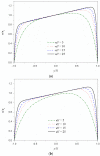An Exact Solution for Power-Law Fluids in a Slit Microchannel with Different Zeta Potentials under Electroosmotic Forces
- PMID: 30424437
- PMCID: PMC6215311
- DOI: 10.3390/mi9100504
An Exact Solution for Power-Law Fluids in a Slit Microchannel with Different Zeta Potentials under Electroosmotic Forces
Abstract
Electroosmotic flow (EOF) is one of the most important techniques in a microfluidic system. Many microfluidic devices are made from a combination of different materials, and thus asymmetric electrochemical boundary conditions should be applied for the reasonable analysis of the EOF. In this study, the EOF of power-law fluids in a slit microchannel with different zeta potentials at the top and bottom walls are studied analytically. The flow is assumed to be steady, fully developed, and unidirectional with no applied pressure. The continuity equation, the Cauchy momentum equation, and the linearized Poisson-Boltzmann equation are solved for the velocity field. The exact solutions of the velocity distribution are obtained in terms of the Appell's first hypergeometric functions. The velocity distributions are investigated and discussed as a function of the fluid behavior index, Debye length, and the difference in the zeta potential between the top and bottom.
Keywords: Asymmetric zeta potential; Electroosmosis; Non-Newtonian fluid; Power-law fluid.
Conflict of interest statement
The authors declare no conflict of interest.
Figures




References
-
- Squires T.M., Quake S.R. Microfluidics: Fluid physics at the nanoliter scale. Rev. Mod. Phys. 2005;77:977–1026. doi: 10.1103/RevModPhys.77.977. - DOI
-
- Gravesen P., Branebjerg J., Jensen O.S. Microfluidics-a review. J. Micromech. Microeng. 1993;3:168. doi: 10.1088/0960-1317/3/4/002. - DOI
-
- Akers A., Gassman M., Smith R. Hydraulic Power System Analysis. CRC Press; Boca Raton, FL, USA: 2006.
-
- Lyklema J. Fundamentals of Interface and Colloid Science: Solid-Liquid Interfaces. 1st ed. Academic Press; London, UK: 1995.
Grants and funding
LinkOut - more resources
Full Text Sources

